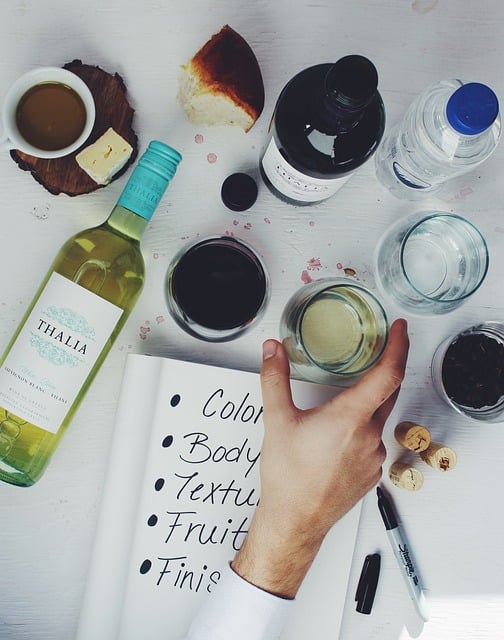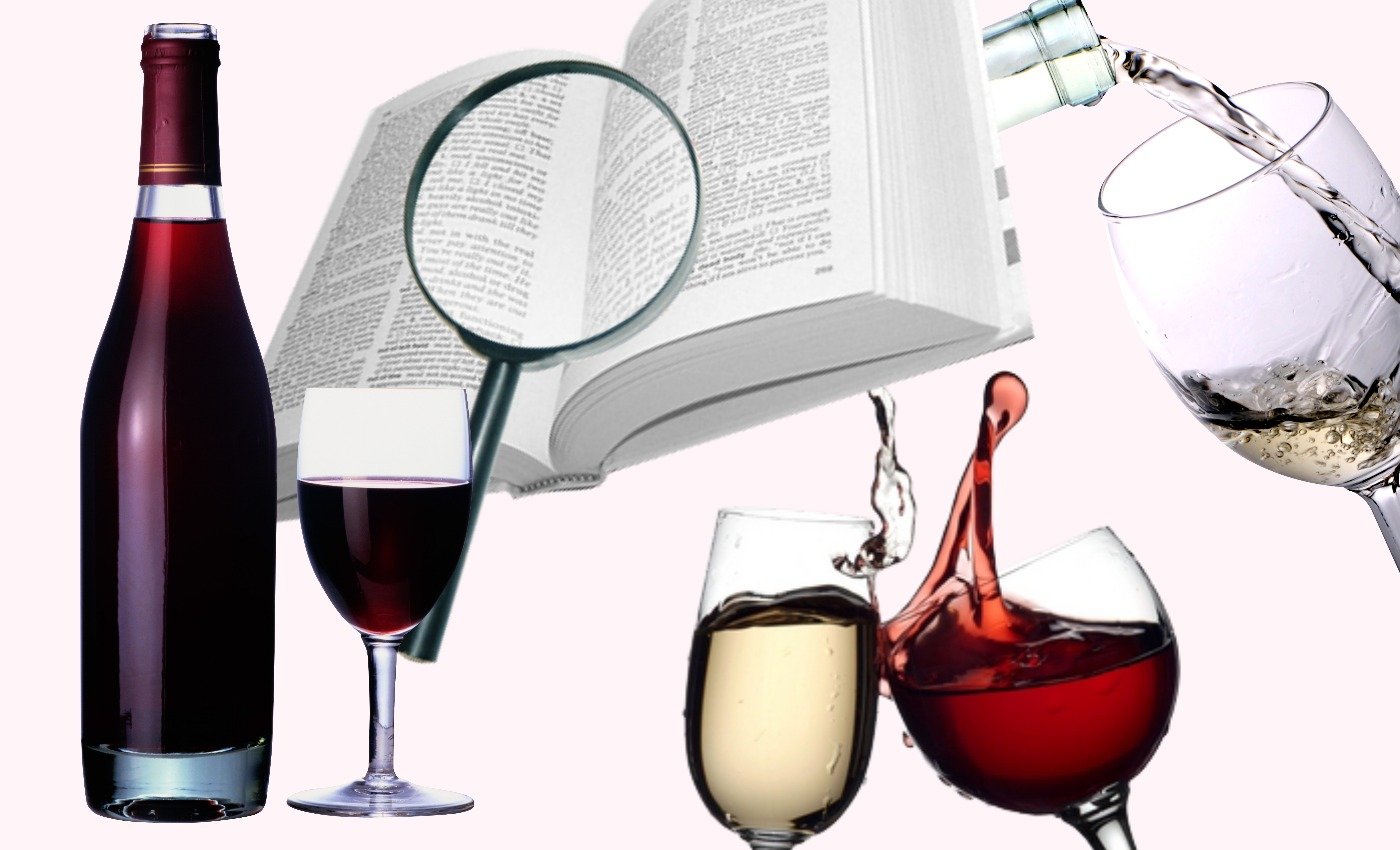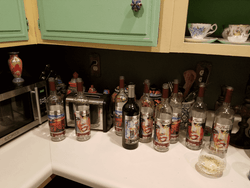Knowing wine terms has a plethora of benefits even if you’re not a frequent wine drinker. Wine is one of the oldest alcoholic beverages. It is often associated with regality and fine events. There is a lot of information about wine to absorb- its quality, flavor, and origin. It can be very intimidating for beginner wine drinkers to describe and discuss what they are experiencing. Having a basic knowledge of wine words and wine terms will allow you to enjoy a wine tasting more. From office parties, holiday parties, or a night out with friends familiarize yourself with some of the following wine terms.
I’ll go over basic wine terminology in this wine glossary. I’ll also be adding more wine terms over time, so be sure to check back often!
“Anyone who tries to make you believe that he knows all about wines is obviously a fake.”
― Leon Adams, The Commonsense Book of Wine
 Acidity: The crispness or almost sourness that leaves a sharp taste on the palate.
Acidity: The crispness or almost sourness that leaves a sharp taste on the palate.
Aeration: The process of exposing wine to oxygen, usually done through swirling the wine in a class. It is thought that oxygen will soften the taste of the wine, especially in reds.
Aging: Holding wine in barrels, tanks, and bottles to advance or refine the taste.
Anosmia: Loss of the sense of smell.
Appellation: A legally protected geographical identification of where grapes used in the wine were grown.
Aroma: The smell of wine, with close attention usually paid to the smell of the oak or bottle the wine was contained in.
Astringent: A tasting term that refers to rough, harsh, almost puckering effect of a taste of wine. Usually apparent in high acidity red wines and few white wines.
Balance: A balanced wine is a wine where all flavors and elements are presented equally. It should be without any sensation dominating the taste.
Barrel: The oak container used for fermenting and aging wine.
Barrique: A 225-liter oak barrel where wine is typically stored for aging.
Bitter: Describes one of four basic tastes: bitter, sweet, salty, or sour. Some grapes used for wine have a particularly bitter sensation. Tannins also may cause bitterness in the wine.
Blend: Blends are made from more than one type of grape.
Body: The impression of the weight or fullness of the wine on the palate. Wine is commonly referred to as full-bodied, medium-bodied, or light-bodied.
Bordeaux: An area of Southwest France which is famous for its wine production.
Botrytis: A fungus/mold that dehydrates grapes, producing grape juice very high in sugar. Typically used for dessert wines.
Bouquet: Similar to aroma, the bouquet refers to the scent of the wine, typically used more for older, mature wines.
Brettanomyces: A wine-spoiling yeast that produces barnyard or metallic aromas in the wine.
Briary: Describes wines with an earthy or berry characteristic.
Brilliant: Describes the appearance of light or clear wines, can represent a highly filtered wine.
Brut: A type of champagne, very dry and unsweet.
“Wine is the most healthful and most hygienic of beverages.”
― Louis Pasteur
Chaptalization: Adding sugar to wine before or during the fermentation process to increase the alcohol content of the wine. An illegal or highly regulated activity around the world.
Closed: Describes wines that are premature, and lack aroma or flavor.
Complex: A wine that presents with numerous flavors and odors.
Cork taint: Describes wine which has a musty or off-putting flavor caused by a tainted cork.
Cru Classe: A group of vineyards recognized for quality in France.
Crush: An English term referring to harvest.
Cuvee: A blended batch of wine, in Champagne.
Demi-sec: A French term meaning “half-dry”, often used to describe sparkling wines.
Dry: A wine that has no perceptible taste of sugar, causes puckering sensation of the mouth.
Earthy: Used as a positive and negative description for flavor. At its best, earthy can refer to the pleasant quality that attributes to aroma and flavor. On a negative note, can refer to wine as funky with a barnyard characteristic.
Enology: The science of wine and wine-making.
Fining: Removing unwanted particles from the wine.
Finish: Also called the aftertaste, a measure of the taste and flavor that lingers in the mouth. Great wines are regarded as having a great finish.
Fruity: Having the aroma or taste of fruits.
Herbaceous: The captured taste or aroma of herbs in wine.
Hot: Wines that are high in alcohol but not well-balanced, leaving the taster with a burn or “heat” after finishing.
Length: The amount of time the wine lingers and persists on the palate after finishing a taste
“Beer is made by men, wine by God.”
― Martin Luther
Malic acid: A tart-tasting acid that occurs naturally in several fruits such as plums, apples, or cherries.
Malolactic fermentation: A secondary type of fermentation in which the tartness of malic acid is converted to a smoother flavor.
Mature: Refers to a wine that is ready to drink.
Negociant: The French word describing wine vendors.
Noble rot: Another term for botrytis.
Oak/oaky: Describes the sensation transferred into the wine from the oak barrels wine is stored in. Vanilla, dill, smoky, or similar to baking spices constitute an oaky flavor. Oaky can be a good or bad connotation, dependent on the delivery of the flavor.
Peak: Refers to when a wine is at its very best quality, often subjective to the taster’s preferences.
Phenolic compounds: The natural elements and compounds present in the skins and seeds of grapes.
Phylloxera: A small insect that attacks grapevine roots, killing the plant.
Plonk: British slang for cheap, inexpensive or low-quality wine.
Rough: A “coarse” sensation one experiences when tasting astringent wines.
Sec: The French word for “dry.”
Sommelier: A certified wine professional.
Spicy: A wine tasting term used to describe sensations of bay leaves, paprika, or any other baking spices detected in wine.
Sweet: Wines with perceptible sugar, the opposite of dry wine.
“Age is just a number. It’s totally irrelevant unless, of course, you happen to be a bottle of wine.”
― Joan Collins
Tannins: A compound in wine that is derived from the grape skins, seeds, and stems. It gives the wine the dry, puckering sensation.
Tartaric acid: The main acid in grapes which promotes flavor and aging in wine.
Texture: A wine tasting term describing how wine is experienced on the palate.
Tinny: A metallic tasting wine.
Typicity: Refers to a wine that expresses the characteristics of the grapes used for the production of that wine.
Ullage: A wine term for the space left in barrels or bottles as wine evaporates.
Vegetal: A tasting term describing hints of vegetables in the wine. Cabernet Sauvignon is an example of a wine with a vegetal taste. It is said to be a pivotal characteristic of this wine.
Velvety: A tasting term describing smooth wine, an almost silky sensation.
Vinification: The term for the winemaking process.
Vinology: The study of wine and winemaking.
Yield: Describes the productivity of a vineyard.
Alright, that’s a lot- but that’s not all by any means! A lot of wine regions have their own wine terms, phrases, and vocabulary. These terms explain characteristics, tools, or tastes of the region’s native wines. Wine can be a complex drink or just something you enjoy by the glass but knowledge is power! Wine isn’t going away any time soon so educating yourself with a few wine terms will help open your mind. Welcome to the world of wine!
Cheers!






